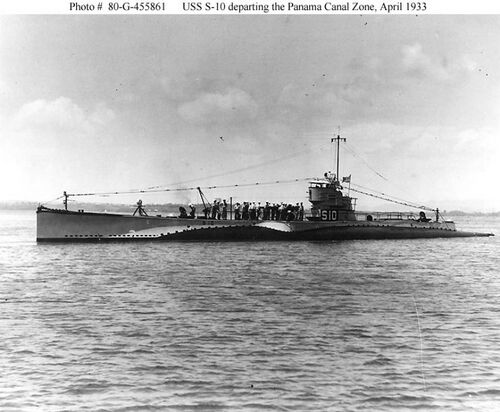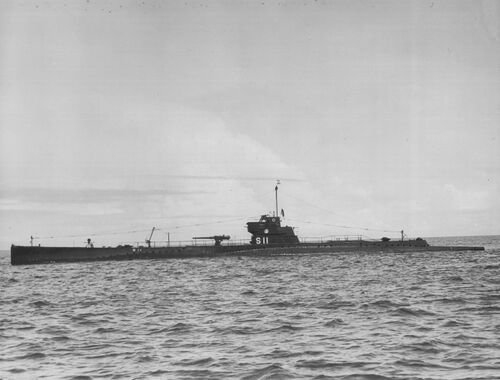S-10 through S-13: Difference between revisions
Pbcjohnston (talk | contribs) →Design and Construction Notes: Additional info |
Pbcjohnston (talk | contribs) Added new Header |
||
| (2 intermediate revisions by the same user not shown) | |||
| Line 1: | Line 1: | ||
[[File:S- | [[File:New Header Govt S-class.jpg]] | ||
=== <big>Design and Construction Notes</big> === | === <big>Design and Construction Notes</big> === | ||
| Line 5: | Line 5: | ||
In addition, the somewhat unreliable performance of the NELSECO/MAN/BuEng diesels engines of the previous boats prompted the BuEng engineers to go back to the original MAN company drawings and they produced a copy directly from those plans at the New York Navy Yard in Brooklyn, eliminating the NELSECO middleman. These BuEng/MAN S6V45/42 engines, while still not perfect, were vast improvements and were considered to be quite reliable. | In addition, the somewhat unreliable performance of the NELSECO/MAN/BuEng diesels engines of the previous boats prompted the BuEng engineers to go back to the original MAN company drawings and they produced a copy directly from those plans at the New York Navy Yard in Brooklyn, eliminating the NELSECO middleman. These BuEng/MAN S6V45/42 engines, while still not perfect, were vast improvements and were considered to be quite reliable. | ||
A forward extension of the conning tower fairwater that had originally housed a ready service locker for ammunition for the 4"/50 caliber deck gun was removed during refits for all four boats during the late 1920s. The reason for the removal of this extension is not entirely clear, but may have been due to ongoing corrosion control proplems. | |||
This group of four boats were considered amongst the best of the Government design. All but S-10 were retained and served again during WWII, providing training for new submarine crews and running anti U-boat patrols. | This group of four boats were considered amongst the best of the Government design. All but S-10 were retained and served again during WWII, providing training for new submarine crews and running anti U-boat patrols. | ||
The webmasters uncovered an anecdotal and unverified report that by the mid 1930's S-10 was suffering from serious corrosion issues in the outer hull, particularly aft. S-10 was decommissioned and scrapped in the summer and fall of 1936 while her three sisters were retained. It is likely that S-10 was decommissioned to keep the Submarine Service within the limits of the London Naval Treaty as new fleet boats were being commissioned, and the corrosion issues she was facing likely made the decision to discard her easier. | The webmasters uncovered an anecdotal and unverified report that by the mid 1930's S-10 was suffering from serious corrosion issues in the outer hull, particularly aft. S-10 was decommissioned and scrapped in the summer and fall of 1936 while her three sisters were retained. It is likely that S-10 was decommissioned to keep the Submarine Service within the limits of the [https://en.wikipedia.org/wiki/London_Naval_Treaty '''London Naval Treaty'''] as new fleet boats were being commissioned, and the corrosion issues she was facing likely made the decision to discard her easier. | ||
For more details, please see [https://pigboats.com/images/3/31/A_VISUAL_GUIDE_TO_THE_S-CLASS_SUBMARINES_PART_2_5th_edition.pdf '''the article at this link'''].</span></div> | For more details, please see [https://pigboats.com/images/3/31/A_VISUAL_GUIDE_TO_THE_S-CLASS_SUBMARINES_PART_2_5th_edition.pdf '''the article at this link'''].</span></div> | ||
Latest revision as of 18:59, 17 March 2025
Design and Construction Notes
In addition, the somewhat unreliable performance of the NELSECO/MAN/BuEng diesels engines of the previous boats prompted the BuEng engineers to go back to the original MAN company drawings and they produced a copy directly from those plans at the New York Navy Yard in Brooklyn, eliminating the NELSECO middleman. These BuEng/MAN S6V45/42 engines, while still not perfect, were vast improvements and were considered to be quite reliable.
A forward extension of the conning tower fairwater that had originally housed a ready service locker for ammunition for the 4"/50 caliber deck gun was removed during refits for all four boats during the late 1920s. The reason for the removal of this extension is not entirely clear, but may have been due to ongoing corrosion control proplems.
This group of four boats were considered amongst the best of the Government design. All but S-10 were retained and served again during WWII, providing training for new submarine crews and running anti U-boat patrols.
The webmasters uncovered an anecdotal and unverified report that by the mid 1930's S-10 was suffering from serious corrosion issues in the outer hull, particularly aft. S-10 was decommissioned and scrapped in the summer and fall of 1936 while her three sisters were retained. It is likely that S-10 was decommissioned to keep the Submarine Service within the limits of the London Naval Treaty as new fleet boats were being commissioned, and the corrosion issues she was facing likely made the decision to discard her easier.
For more details, please see the article at this link.S-10 (SS-115)

S-11 (SS-116)

S-12 (SS-117)

S-13 (SS-118)

Page created by:
Ric Hedman & David Johnston
1999 - 2023 - PigBoats.COM©
Mountlake Terrace, WA, Norfolk, VA
webmaster at pigboats dot com
